In the world of SEO, experts in the space frequently emphasize the importance of title tags. But why?
Backlinko analyzed 11.8 million search results and found that the overwhelming majority of title tags in Google exactly or partially match the keyword that they rank for. That being said, they found only a slight correlation between using a keyword in your title tag and higher rankings on the first page.
So what is the truth? Because many resources that specialize in SEO advice like MOZ, Ahrefs, SearchEngineJournal, and even Backlinko (despite his findings) have written guides on why optimizing title tags for SEO is important.
In order to separate fact from fiction, I’m going to take you through the ins and outs of title tags, and show the data behind why they are important and how publishers can test them.
We also have a video on title tags that walks through this information.
What are title tags?
Title tags are a piece of HTML code that indicates the title of a web page and gives a user an idea of what the page is about. To put it simply, title tags are necessary for search engine results pages (SERPs), social media sharing, and user experience. They’re also the first impression a user has of your content and your brand. This is one of the many reasons why they’re more important than most people think.
Below is an example of the title tag for the Ezoic home page on Google Search.

If we take a look at the page source, the title tag is visible. It’s introduced in the HTML by the <title> piece of code which is pulling out the desired title. There’s also a handful of meta tags that tell web crawlers, Googlebot, and Bingbot that this specific page is to be followed. This means it allowed to be indexed on search engines.

But there are also pages that you might want Google (or other search engines) not to crawl and follow. A great example of this is affiliate links. Publishers used to use rel=nofollow but now Google as of March 1st, 2020 wants publishers to use the attribute rel=sponsored. We wrote an article that shows you how to change your links to rel=follow like Google wants.
How to write a great title tag for SEO
Step 1: Choose your keyword
Let’s say I’m a travel blogger, and I randomly chose the keyword “Things to do in Prague.” The first thing I’m going to do is go to Google and check out the SERP for this keyword.
The first thing I notice is that the majority of the results are numbered lists. This information gives us hints about the types of content Google feels people are looking for with this specific query. The volume of the query is 60,500 a month. And judging by the websites in the results, if my travel site doesn’t have high domain authority, it will likely be difficult to rank on the first page of Google.

But that’s the reality of keyword research and content strategy. Sometimes, the first keyword you look at isn’t going to be the one you go with. At the same time, I have content about Prague that I want to publish. So instead of targeting “Things to do in Prague,” I want to look for a better candidate in the “People Also Ask.” section of Keywords Everywhere, a popular (and affordable) keyword research tool.
Step 2: Look for long-tail variants of your main keyword
I can see that there’s a handful of keywords that could be tied together into an article. While “Things to do in Prague,” is broad and would be really hard to rank for, I can see there’s an opportunity to do an article on Prague’s nightlife.
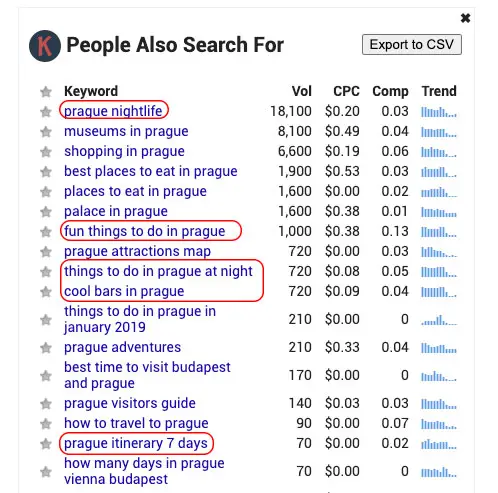
You should always choose one main keyword that gets a larger amount of search volume. It may be hard to rank for it in the beginning, but if you can successfully target long-tail variations of that same keyword, you’ll rank for those lower-volume keywords faster.
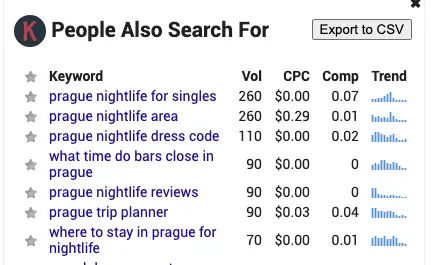
But some of these long-tail variations have a bit too high of a search volume to target without high domain authority, so I’m going to look at variants of “Prague nightlife” specific keywords.
Main keyword: Prague nightlife (18,100 searches/month)
Long-tail variant #1: Prague nightlife reviews (90 searches/month)
Long-tail variant #2: Prague trip planner (90 searches/month)
Choosing these 3 will now help us build our article title.
Step 3: Craft your title
First and foremost, be descriptive. Ask yourself questions about what makes your content unique.
- Is it deep/thorough information?
- Does it list items (numbered/top things/etc)?
- Is it concise and only answer one thing (brevity-focused)?
- Does it take a different angle than other available info?
- Freshness/newness (is it specific to a certain year?)
These are some of the things you can bake into your title. You want to capture people’s attention, while also focusing on SEO.
Prague Nightlife Trip Planner: My 7-Day Itinerary (With Reviews)
This title hits all three keywords with enough variation to potentially rank for them. Remember, SEO is part art, part science. Which means you need to learn by trial and error. Test your theories, lose what doesn’t work, and repeat what does.
And in reality, learning SEO yourself is the best way to grow your content strategy skills. Avoid scammy SEO gurus who will charge you big bucks yet oftentimes deliver you no real value, or advice you can simply find online for free.
Can you optimize title tags for SEO?
Absolutely. Outside of using the 3 steps in the previous section for crafting good title tags, there are many SEO tips for optimizing title tags. A small example of this is how there’s been speculation that “frontloading” your keyword in your title tags has SEO benefits.
For example: Which title tag is better?
Find Local Dog Groomers – Dog Groomer Locator by Pet Parents
Dog Groomer Locator by Pet Parents: Find Local Groomers Near You
If the website petparents.com’s keyword is dog groomer locator, the second option has that keyword frontloaded. While Ahrefs and Backlinko have only found weak correlations between frontloading a keyword and rankings, it might be worth it to test. To do this, you’d need to test the URL of a landing page (or article) before and after the title change.

If you submit a URL in Google Search Console to be re-crawled, it usually takes a few days for any change to take effect. Set your comparison dates with that consideration in mind and see if there is an increase in clicks on Google Analytics.
Note: If you change your title tags for an article or landing page, never alter the URL. Altering the URL will cause broken internal linking and backlinks to the article, and unless you set up a URL redirect, it’s not worth it. Even when a redirect is set up, you might lose some of the URL authority from the original URL.
How to test title tags for SEO
If you want to test your title tags, there’s not really an easy solution besides doing it the old fashion way—A/B testing.
But A/B testing takes a lot of calculating, and there’s always a bit of guesswork involved to tell when Google has crawled and re-index your updated title tag. Plus, what if you decide you want to test a third title variation? Then it gets even more complicated.
Ezoic’s currently beta testing a new application—the Tag Tester which solves the problem of A/B testing for title tags.
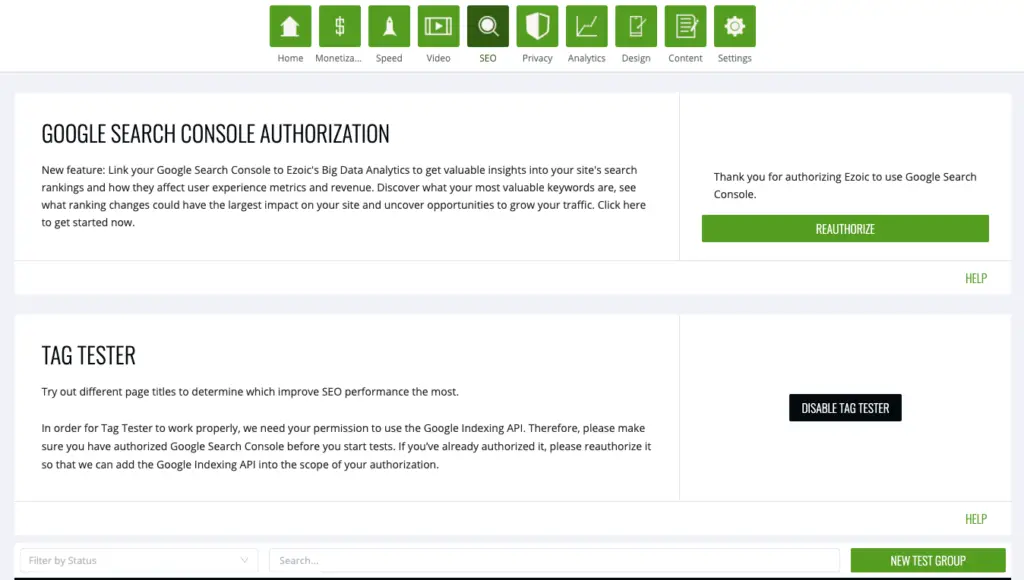
In order for the Tag Tester to work properly, Ezoic needs permission to use the Google Indexing API. Once you’ve authorized Google Search Console in the dashboard, you can begin testing. You can test two titles against your original title, and the test takes a week to two weeks to fully complete.
The great thing? Is that the Tag Tester will automatically change the title to the winning variation automatically. You can still edit it if you’d like, but all of it happens without you having to do the heavy lifting.
The publisher below’s test showed that title test Variation B was the winner for average ranking.
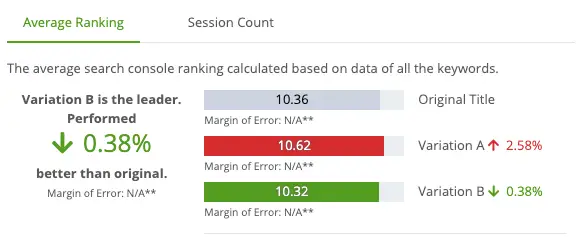
The Tag Tester also shows you which title performs the best across other metrics like Average Pageviews per Visit, Bounce Rate, CTR, Session Count, and the ‘Total Score’—which determines an overall winner across all metrics.
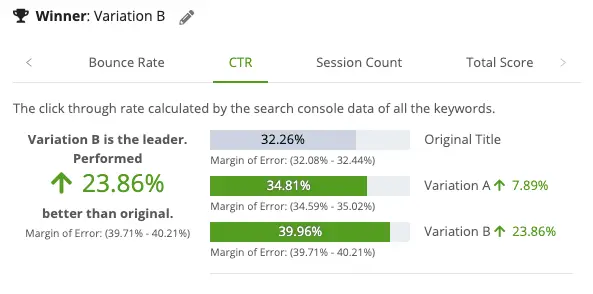
Additionally, the tool gives you total control to create the two title variations that Ezoic’s system will test against the original title.
Wrapping up title tags and why they matter for SEO
Although often overlooked, title tags are objectively important. They are the first impression a user gets of your content, brand, and whether or not they will click your link might depend on how effective they are at enticing them.
When creating title tags, remember to do the following:
- Choose a main keyword
- Look for long-tail variants of the main keyword
- Be descriptive when crafting your title tag
You can always test title tags, but using tools like Ezoic’s Tag Tester will take out the guesswork and streamline your content strategy and SEO efforts.
Do you have any questions on title tags, why they matter for SEO, and how to test them? Let me know in the comments.

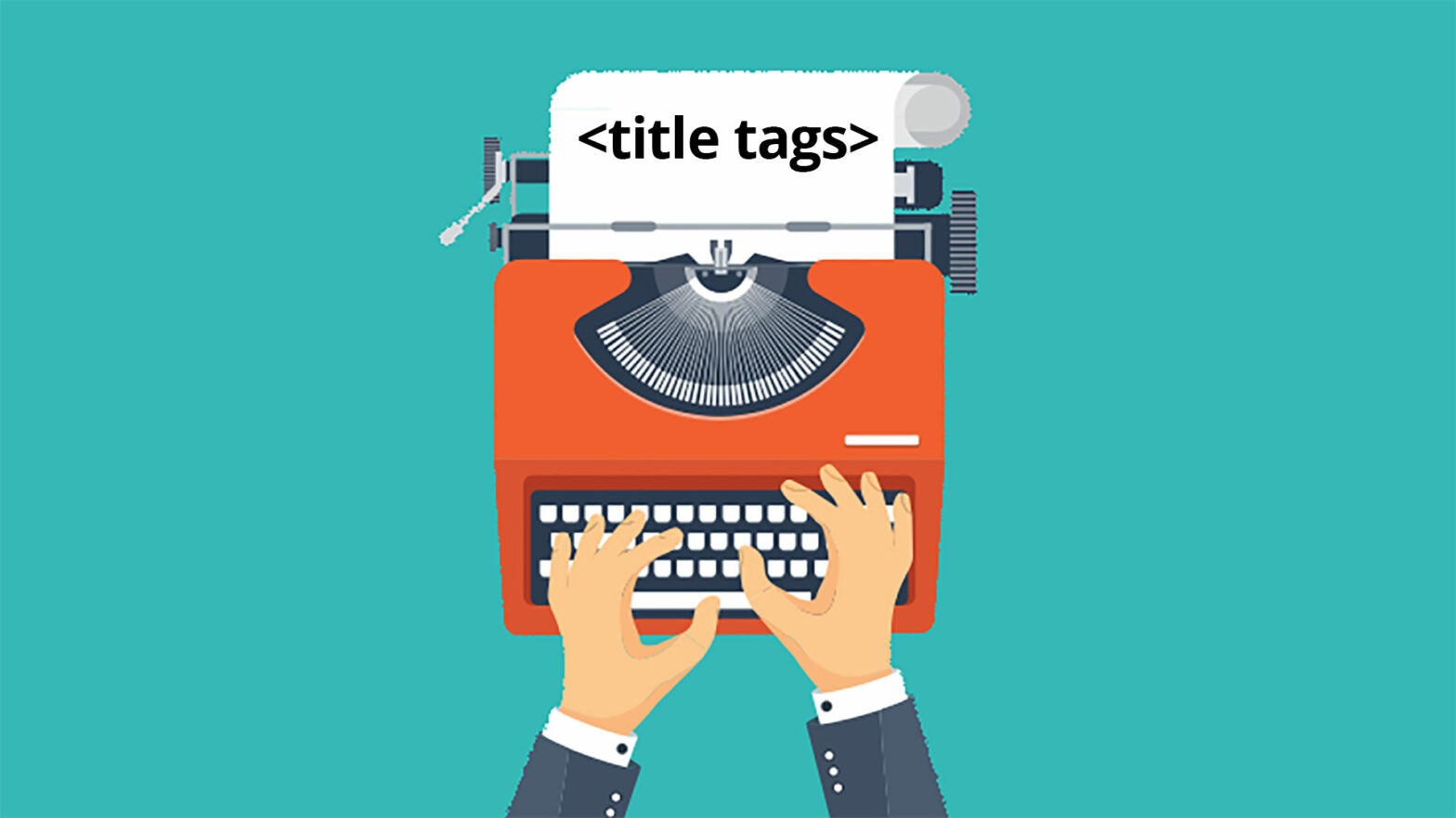
Title tags does improve ranking if it stands out from the rest of the competitors. I will try out the tag tester soon.
This is definitely a great tool to have. How can we enable it in our Ezoic account?
Hi Usman, right now the Tag Tester is still in beta testing. We will make an announcement when the tool becomes available for all Ezoic publishers soon.
This is an awesome article, so thank you! I am definitely using this advice on Titles for my websites. Thanks.